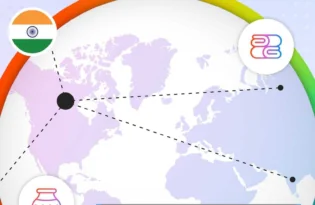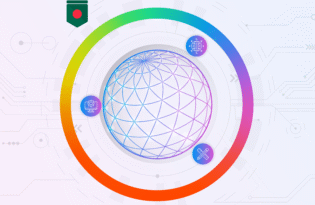Breaking Barriers: The Rise of Indian E-commerce and Service Exporters in Untapped Global Markets
Beyond metros and mega-brands, a new generation of Indian exporters is gaining ground in lesser-known global markets—driven by bold choices, digital reach, and the right financial partners. Learn how digital-first strategies, niche targeting, and frictionless cross-border payments are powering their rise.

India’s digital and export-driven businesses are quietly reshaping global trade patterns. While global markets navigate evolving trade policies and economic shifts, Indian exporters are moving ahead with smart strategies and bold ambition. Trade with ASEAN nations is on track to reach $300 billion by 2025, and the new UK-India Free Trade Agreement (FTA) opens tariff-free access for 99% of Indian exports.
This is a game-changer, especially for India’s small and mid-sized businesses (SMBs), which sell a wide range of products, including textiles, handicrafts, IT services, and software. These companies are no longer relying only on Western markets. Instead, they’re tapping into growing demand across Asia, Africa, and beyond. With strong digital tools, skilled talent, and supportive trade policies, Indian businesses are proving that agility and smart market choices can navigate tariff challenges and drive global success.
The Shifting Global Trade Environment
The global trade landscape is evolving rapidly, shaped by policy changes, tariffs, and economic fluctuations. For Indian businesses, these shifts present opportunities to grow strategically.
How Market Volatility Creates Opportunities
In 2024, Indian SMBs faced significant challenges due to global economic uncertainties. CPA Australia conduced the Asia-Pacific Small Business Survey in 2025 that revealed 71.8% of Indian businesses sought external funding during the year, highlighting a strong demand for financial support in the sector.
Despite these challenges, Indian small and medium enterprises (SMEs) demonstrated remarkable resilience. The number of exporting small businesses increased from 52,849 in 2020-21 to 173,350 in 2024-25, with the sector contributing 45.79% to India’s exports by May 2024.
Additionally, the total value of MSME exports rose from the $45-50 billion range in 2020-21 to the $140-145 billion range in 2024-25, underscoring their critical role in boosting India’s economy and strengthening global trade.
These numbers tell a powerful story: while global trade faces headwinds from tariffs and policy shifts, Indian businesses are finding new paths to prosperity through strategic market selection and service innovation.
India’s Export Diversification Strategy
Indian businesses are adopting innovative market diversification strategies, reducing reliance on traditional export markets while building resilience against tariff impacts.
Blueprint for Trade Pattern Evolution
The cumulative value of merchandise exports during FY25 was $437.42 billion, demonstrating India’s continued strength in global markets. India’s export basket has evolved significantly, with key drivers being electronic goods, drugs & pharmaceuticals, engineering goods, and textiles, while India’s services export continues to complement merchandise trade.
The cross-sector opportunities span manufacturing, textiles, and value-added services. Indian businesses are moving up the value chain, offering sophisticated products and services that command premium prices in international markets.
Emerging High-Growth Trade Corridor Opportunities: Your Next Big Markets
Several high-potential trade corridors are opening new avenues away from the tariff-affected routes for Indian exporters to diversify their client base and reduce market concentration risks seeking growth opportunities.
UK Market Momentum: The Post-Brexit Advantage
After Brexit, the UK is looking for new global trade partners, and India plays a crucial role in this strategy. The India-UK Free Trade Agreement, concluded on May 6, 2025, marks a watershed moment. The deal aims to increase bilateral trade by £25.5 billion by 2040.
Under the FTA, nearly 99% of Indian exports to the UK will be tariff-free, benefiting textiles, marine products, leather goods, gems and jewellery, and engineering goods. Indian professionals on short-term UK assignments are exempt from National Insurance contributions for three years.
The UK market also has a high demand for services such as technology solutions, IT consulting, digital marketing, and financial services. Companies in India, especially in tech and services, are well-positioned to meet these needs.
Middle East Growth: Digital Transformation Goldmine
The Gulf countries are rapidly modernizing their industries through the adoption of digital technologies such as AI, cloud computing, and automation, creating vast opportunities for service providers specializing in these fields.
In line with this transformation, the India-Middle East-Europe Economic Corridor (IMEC), launched in September 2023, will further strengthen connectivity between India and the Gulf markets. By reducing transit times by 40% and cutting costs by 30% while establishing a high-speed digital network, the corridor will facilitate smoother trade and communication between the regions.
As the Middle East continues its efforts to modernize and diversify its economy, the demand for services such as cybersecurity, cloud computing, IT consulting, and digital marketing is rapidly growing. This presents a significant opportunity for Indian businesses that can leverage these advancements.
Southeast Asia Expansion: A Shared Growth Story
The ASEAN region’s rapidly growing digital economy presents significant opportunities for Indian businesses, with bilateral trade projected to reach $300 billion by 2025, up from $96.79 billion in the 2018–19 fiscal year.
Following the Free Trade Agreement (FTA), India’s exports to key ASEAN countries – including Thailand, Cambodia, Vietnam, Malaysia, and the Philippines – have seen substantial growth.
This surge is driven by Southeast Asia’s growing demand for digital services, including cloud solutions, e-commerce platforms, and digital marketing. India is well-positioned to meet this demand, thanks to its skilled tech workforce and shared timezone with many ASEAN nations, which enables seamless, real-time collaboration.
To successfully enter and thrive in these markets, Indian businesses should adopt tailored strategies, such as forming local partnerships, focusing on high-growth sectors like fintech, and customizing their offerings to meet local needs, thereby ensuring both relevance and a competitive advantage in the region.
Strategic Adaptation for Service Providers: From Cost to Value Leadership
Service providers are adjusting the way they work to stay competitive and meet changing client needs. Instead of focusing only on offering low-cost services, many are now emphasizing the value they deliver and the specific results their clients want.
Value Repositioning Wins Contracts
Companies are moving from cost-based to value-based models. This means:
- Outcome-focused packages: Design services around specific client goals rather than hourly rates. When receiving payments for value-based contracts, having a trusted cross-border payment partner like Payoneer helps structure deals attractively.
- Flexible engagement models: Offer various contract lengths and pricing structures to accommodate different budgets affected by economic pressures.
- ROI demonstrations: Show clear returns on investment to justify premium pricing despite global cost pressures.
Strategic Service Portfolio Diversification
To meet a broader set of needs, service providers are expanding into related areas. India has over 30% of graduates in STEM fields, providing a deep talent pool. Companies are:
- Building industry expertise: Developing deep knowledge in healthcare, finance, or education creates differentiation.
- Creating proprietary frameworks: Custom methodologies for specific clients need command premium rates.
- Investing in continuous learning: Keeping teams updated with latest technologies maintains competitive edges.
Optimizing Service Delivery for New Markets
To succeed in new international markets, Indian service providers must focus on two key areas: operational efficiency and market-specific customization. These help businesses stay competitive and meet the unique needs of each region.
Operational Efficiency That Scales
- Enhanced remote collaboration strategies: Implement advanced project management frameworks, establish clear communication protocols, and leverage AI-powered collaboration tools to maximize productivity across distributed teams..
- Quality assurance and delivery consistency: Make sure services are delivered with the same high standards every time, regardless of location.
- Talent development for market-specific needs: Train employees to meet the demands of different markets. India already has a strong talent base, with 25% of the world’s science and engineering graduates. India also has the largest percentage of female STEM graduates in higher education, according to the World Bank, contributing to a diverse and innovative workforce.
Market-specific Customization Strategies
- Cultural adaptation and localization: Understand local customs, languages, and preferences to better connect with clients.
- Compliance with regional regulations: Navigate complex regulatory landscapes proactively, ensuring adherence to local standards while building trust and credibility in each market.
- Time zone and communication optimization: Adjust working hours or use flexible schedules to improve communication across time zones.
Strengthening Financial Infrastructure for Global Success
As Indian businesses go global, reliable financial infrastructure becomes a key differentiator. Payoneer acts as a financial partner that helps Indian service providers operate smoothly and expand successfully in global markets.
Streamlining Global Payments Operations
- Multi-currency accounts: Get local receiving account details in countries like the US, UK, and EU, and manage your earnings in multiple currencies (USD, EUR, GBP, etc.)—all in one place, helping you reduce conversion costs and operate like a local globally.
- Simplified billing: Send invoices and accept payments from clients worldwide through various methods (bank transfer, card, etc.).
Building Trust with Global Clients
- Trusted global partner: Payoneer serves customers in 190+ countries and territories, leveraging relationships with nearly 100 banking and payment service providers. With approximately two million active customers, Payoneer processed $80 billion in volume in 2024, providing secure and reliable payment solutions.
- Regulatory compliance: Licensed in key markets including the US, UK, EU, Singapore, Japan, and Hong Kong, ensuring strong security and fraud protection.
- Multi-language support: Customer service available in 20+ languages for easy communication and global client trust.
Your Roadmap to Sustainable Global Growth
India’s service sector stands poised to lead the global digital economy. With strong talent, innovation capabilities, and government support, Indian service providers are seizing opportunities across UK, the Middle East, and Southeast Asian markets.
Strategic shifts toward value-based models, market customization, and robust financial infrastructure help businesses overcome tariff-related barriers and scale sustainably. By focusing on operational excellence, client-centric delivery, and continuous innovation, India builds long-term global partnerships.
The path forward is clear: embrace emerging trade corridors, leverage India’s unique advantages, and equip your business with professional global financial tools like Payoneer. India can not only expand its global footprint but also build long-term partnerships that drive inclusive and resilient growth.
Disclaimer
Nothing herein should be construed as if Payoneer Inc. or its affiliates are soliciting or inviting any person outside the jurisdiction where it operates/is licensed to engage in payment services provided by Payoneer Inc. or its affiliates, unless permitted by applicable laws. Any products/services availability are subject to customer’s eligibility. Not all products/services are available in all jurisdictions in the same manner. Depending on your eligibility, you may be offered with the Corporate Purchasing Mastercard, issued by First Century Bank, N.A., under a license by Mastercard® and provided to you by Payoneer Inc., or the Payoneer Business Premium Debit Mastercard®, issued and provided from Ireland by Payoneer Europe Limited under a license by Mastercard. The Payoneer Business Premium Debit Mastercard® cannot be used at merchants or ATMs in Hong Kong or for HKD payments. If you are located in the EEA, all Payoneer Services will be provided to you by Payoneer Europe Limited, trading as Payoneer and regulated by the Central Bank of Ireland.
The information in this document is intended to be of a general nature and does not constitute legal advice. While we have endeavored to ensure that the information is up to date and correct, we make no representations or warranties of any kind, express or implied, about the completeness, accuracy, reliability or suitability of the information. In no event will we be liable for any loss or damage including without limitation, indirect or consequential loss or damage, or any loss or damage whatsoever incurred in connection with the information provided.
Related resources
Latest articles
-
Planning to hire employees in France? Here’s a quick guide
Looking to hire employees in France for your U.S. company? Learn about employment in France and how Payoneer Workforce Management makes it simple to hire in France.
-
Planning to hire employees in Spain? Here’s a quick guide
Are you looking to hire employees in Spain? Learn about employment in Spain and how Payoneer Workforce Management can help American companies hiring in Spain.
-
How to hire employees in the Netherlands
Looking to hire employees in the Netherlands for your U.S. company? Learn about employment in the Netherlands and how Payoneer Workforce Management can help hire in the Netherlands.
-
How to hire employees in Australia
Looking to hire employees in Australia for your US company? Learn about employment in Australia and how Payoneer Workforce Management makes it easy to hire in Australia.
-
Planning to hire employees in Germany? Here’s a quick guide
Are you looking to hire employees in Germany? Learn about hiring in Germany and how Payoneer Workforce Management can help U.S. companies hiring in Germany.
-
Planning to hire employees in the Philippines? Here’s a quick guide
Wondering how an American company hires employees in the Philippines? Our guide covers how to hire employees in the Philippines and how we can help.
Disclaimer
Nothing herein should be construed as if Payoneer Inc. or its affiliates are soliciting or inviting any person outside the jurisdiction where it operates/is licensed to engage in payment services provided by Payoneer Inc. or its affiliates, unless permitted by applicable laws. Any products/services availability are subject to customer’s eligibility. Not all products/services are available in all jurisdictions in the same manner. Depending on your eligibility, you may be offered with the Corporate Purchasing Mastercard, issued by First Century Bank, N.A., under a license by Mastercard® and provided to you by Payoneer Inc., or the Payoneer Business Premium Debit Mastercard®, issued and provided from Ireland by Payoneer Europe Limited under a license by Mastercard. The Payoneer Business Premium Debit Mastercard® cannot be used at merchants or ATMs in Hong Kong or for HKD payments. If you are located in the EEA, all Payoneer Services will be provided to you by Payoneer Europe Limited, trading as Payoneer and regulated by the Central Bank of Ireland.
The information in this document is intended to be of a general nature and does not constitute legal advice. While we have endeavored to ensure that the information is up to date and correct, we make no representations or warranties of any kind, express or implied, about the completeness, accuracy, reliability or suitability of the information. In no event will we be liable for any loss or damage including without limitation, indirect or consequential loss or damage, or any loss or damage whatsoever incurred in connection with the information provided.















